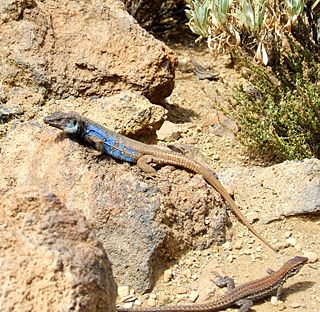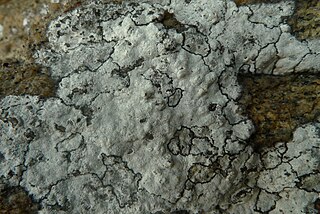Sepsina is a genus of skinks. The genus is endemic to southern Africa.

The genus Gallotia are the lacertids of the Canary Islands. This genus consists of a group that has been evolving there ever since the first islands emerged from the sea over 20 million years ago. The endemic species and subspecies of this group have a number of characteristics that make them quite special within their family (Lacertidae); their only close relatives are the sandrunner lizards (Psammodromus) of the western Mediterranean region. Gallotia are characteristic for eating significant quantities of plants, and for several lineages having evolved insular gigantism.

Philochortus is a genus of lizards of the family Lacertidae. Species of this genus are distributed in Egypt, Algeria, Libya, Mali, Niger, Ethiopia, Djibouti, Eritrea, Somalia, Kenya, Yemen, and Saudi Arabia.

Oligodon is genus of colubrid snakes that was first described by the Austrian zoologist Fitzinger in 1826. This genus is widespread throughout central and tropical Asia.

The La Gomera giant lizard is a lacertid species that can be found on the island of La Gomera, one of the Canary Islands.

The El Hierro giant lizard is a subspecies of lacertid that can be found on the island of El Hierro, one of the Canary Islands. It is considered to be a subspecies of Gallotia simonyi, Simony's lizard. The subspecies was once present throughout much of the island and on the small offshore Roque Chico de Salmor, but is now confined to a few small areas of cliff with sparse vegetation. It is currently restricted to the southern end of the Risco de Tibataje in Fuga de Gorreta, located between Guinea and the so-called Paso del Pino. The species was also successfully reintroduced to the Roque Chico de Salmor in 1999, and subsequent reintroductions have taken place at Julan and at la Dehesa.(Miras & Pérez-Mellado 2005b)

Gallotia simonyi, also known as Simony's lizard, is a species of lacertid that was found on many of the Canary Islands. The species was once present throughout much of the islands, but one of the two subspecies is extinct, while the other, the Roque Chico de Salmor giant lizard is now confined to a few small areas of cliff with sparse vegetation. It is currently restricted to the southern end of the Risco de Tibataje in la Fuga de Gorreta, located between Guinea and the so-called Paso del Pino. The species was also successfully reintroduced to the Roque Chico de Salmor in 1999, and subsequent reintroductions have taken place at Julan and at la Dehesa.(Miras & Pérez-Mellado 2005b)

The Fuerteventura skink is a species of skink in the family Scincidae. Skinks are lizards belonging to the family Scincidae, a family in the infraorder Scincomorpha.
The Sulawesi forest turtle is a critically endangered species of turtle in the family Geoemydidae. The species is monotypic within the genus Leucocephalon. It is endemic to Sulawesi in Indonesia.

Scincinae is a subfamily of lizards. The subfamily contains 33 genera, and the genera contain a combined total of 284 species, commonly called skinks. The systematics is at times controversial. The group is probably paraphyletic. It is one of three subfamilies of the family Scincidae, the other two being Acontinae and Lygosominae.

Roccellographa is a genus of lichen-forming fungi in the family Roccellographaceae. The genus was circumscribed by Austrian lichenologist Julius Steiner in 1902, with Roccellographa cretacea assigned as the type, and at that time, the only species. Three additional species have since been transferred to the genus from other genera.
Antennablennius simonyi, Simony's blenny, is a species of combtooth blenny found in the western Indian Ocean, from the Gulf of Aden to the Persian Gulf. The specific name honours the Austrian mathematician and entomologist Oskar Simony (1852-1915), who looked after the collection of fish specimen on an expedition to Socotra on which the type was collected.

The Abd al-Kuri sparrow is a passerine bird endemic to the small island of Abd al Kuri in the Socotra archipelago of the Indian Ocean, off the Horn of Africa. Though this species was originally described as a distinct species, it was considered conspecific with the Socotra sparrow. A study by Guy Kirwan showed significant differences from the Socotra sparrow, and that the two sparrows might even have different origins. On the evidence that it is morphologically distinct, BirdLife International recognised it as a species, and it was listed in the IOC World Bird List from December 2009. It has a very restricted distribution, and a population of under 1,000 individuals, so despite not having any known threats it is considered a Vulnerable species on the IUCN Red List.
Scortecci's blind snake, also known commonly as Bracciani's worm snake, is a species of snake in the family Leptotyphlopidae. The species is endemic to the Horn of Africa.
Letheobia lumbriciformis, also known as the Zanzibar gracile blind snake or wormlike beaked snake, is a species of snake in the Typhlopidae family. It is endemic to East Africa and is known from northeastern Tanzania and from eastern Kenya.

Grant's leaf-toed gecko is a species of gecko, a lizard in the family Gekkonidae. The species is endemic to Socotra.
Malayodracon is a genus of lizard within the family Agamidae. The genus is monotypic, containing the sole species Malayodracon robinsonii. The species, also known commonly as Robinson's anglehead lizard and Robinson's forest dragon, is endemic to Southeast Asia. No subspecies are recognized as being valid.
The mangrove semaphore gecko is a species of lizard in the family Sphaerodactylidae. The species is endemic to Socotra Island.
Flexiseps ardouini, also known commonly as the yellow skink, is a species of lizard in the family Scincidae. The species is endemic to Madagascar.
Sepsina copei, also known commonly as Cope's reduced-limb skink or the sepsina skink, is a species of lizard in the family Scincidae. The species is endemic to Angola.











